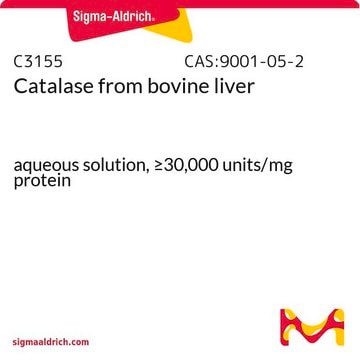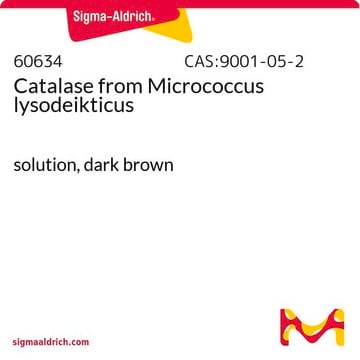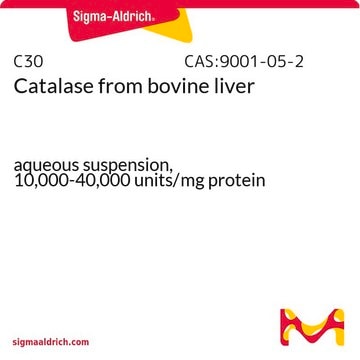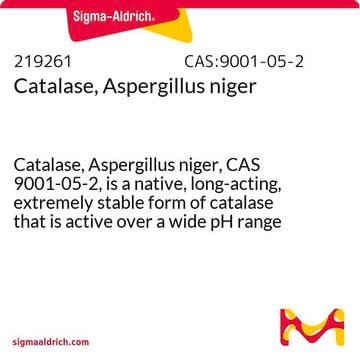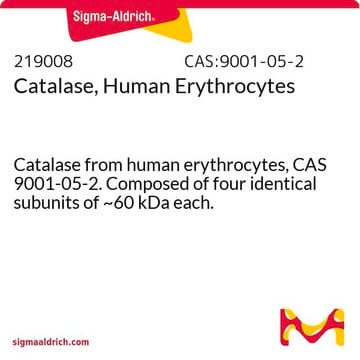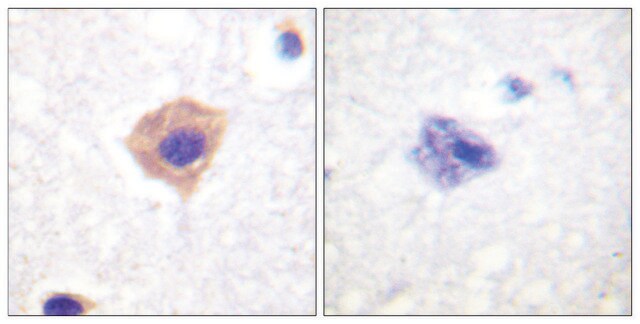02071
Catalase from Corynebacterium glutamicum
solution, deep brown, ≥500000 U/mL
Sign Into View Organizational & Contract Pricing
All Photos(1)
About This Item
CAS Number:
MDL number:
UNSPSC Code:
12352204
NACRES:
NA.54
Recommended Products
biological source
bacterial (Corynebacterium glutamicum)
form
solution
concentration
≥500000 U/mL
color
deep brown
shipped in
wet ice
storage temp.
2-8°C
InChI
1S/C9H10O3/c1-2-12-9(11)7-3-5-8(10)6-4-7/h3-6,10H,2H2,1H3
InChI key
NUVBSKCKDOMJSU-UHFFFAOYSA-N
General description
Catalase is ubiquitously found in animals, plants, fungi, and humans. It is made up of looped polypeptide chains that are arranged as tetramers or dimers and a core, that contains iron or manganese ions. Catalase can be differentiated into two types such as heme-containing (type I), which possesses an iron-porphyrin cofactor and a non-heme-containing (type II), which possesses a dinuclear manganese active site.
Application
Catalase from Corynebacterium glutamicum has been used to identify and characterize purified bacterial peptide (PPBP) produced from Bacillus thuringiensis. It has also been used to study its inhibition by nitric oxide.
Biochem/physiol Actions
Catalase is an antioxidant enzyme that plays a role in alleviating oxidative stress by the removal of hydrogen peroxide to produce oxygen and water. Lower levels of catalase lead to several age-related disorders including hypertension, anemia, vitiligo, Parkinson′s disease, Alzheimer′s disease, schizophrenia, bipolar disorders, diabetes mellitus, and cancer.
Unit Definition
1 U corresponds to the amount of enzyme which decomposes 1 μmol H2O2 per minute at pH 7.0 and 25°C
Physical form
contains ~30% glycerol, 10% ethanol
Signal Word
Warning
Hazard Statements
Precautionary Statements
Hazard Classifications
Flam. Liq. 3
Storage Class Code
3 - Flammable liquids
WGK
WGK 1
Flash Point(F)
105.8 °F - closed cup
Flash Point(C)
41 °C - closed cup
Personal Protective Equipment
dust mask type N95 (US), Eyeshields, Gloves
Certificates of Analysis (COA)
Search for Certificates of Analysis (COA) by entering the products Lot/Batch Number. Lot and Batch Numbers can be found on a product’s label following the words ‘Lot’ or ‘Batch’.
Already Own This Product?
Find documentation for the products that you have recently purchased in the Document Library.
Customers Also Viewed
Nitin Kumar et al.
Science advances, 4(10), eaat7779-eaat7779 (2018-10-20)
Active materials are capable of converting free energy into directional motion, giving rise to notable dynamical phenomena. Developing a general understanding of their structure in relation to the underlying nonequilibrium physics would provide a route toward control of their dynamic
Milka O Montes et al.
International journal of phytoremediation, 15(2), 168-187 (2013-03-16)
Hexavalent chromium is a contaminant highly mobile in the environment that is toxic for plants at low concentrations. In this work, the physiological response of Convolvulus arvensis and Medicago truncatula plants to Cr(VI) treatments was compared. C. arvensis is a
A E Kratnov
Klinicheskaia laboratornaia diagnostika, (12)(12), 10-12 (2013-03-14)
The article deals with the results of study of the intracellular metabolism of neutrophils in 96 patients including 56 (58.3%) patients with ischemic heart disease. It is established that in patients with ischemic heart disease as compared with patients without
Maryam Sharifi-Sanjani et al.
American journal of physiology. Heart and circulatory physiology, 304(10), H1294-H1301 (2013-03-26)
Myocardial metabolites such as adenosine mediate reactive hyperemia, in part, by activating ATP-dependent K(+) (K(ATP)) channels in coronary smooth muscle. In this study, we investigated the role of adenosine A(2A) and A(2B) receptors and their signaling mechanisms in reactive hyperemia.
Dusan Sokolovic et al.
General physiology and biophysics, 32(1), 79-90 (2013-03-28)
The aim of the study was to evaluate the effect of melatonin on oxidative stress, DNA fragmentation, apoptsis and proliferation in thymus tissue of rats exposed to microwaves. Wistar rats were divided in four groups: I - treated with saline;
Our team of scientists has experience in all areas of research including Life Science, Material Science, Chemical Synthesis, Chromatography, Analytical and many others.
Contact Technical Service
